See Page 1 |
2 |
3 |
4 |
5 of the May 2022 homepage archives.
Friday the 6th
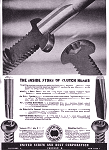 I have always wondered why hex (Allen) or
clutch type heads for everyday wood, metal, and plastic screws and machine screws
(aka small bolts) was not the norm rather than Phillips heads. Phillips heads are
fine when the screws are not hard to get out, but when they are really difficult
to break loose, a lot of force toward the screw is often required whilst turning.
Unless you have a prefect fit between the driver and the screw head, the driver
tends to ride up out of the cross slot. A straight slot screwdriver does not usually
have that issue, but it has the disadvantage of slipping out of the screw slot and
damaging the item it is holding (or your hand). Hex head, Torx head, clutch head,
and other types with vertical walls also do not require a lot of inward force when
really cranking on them. Maybe it's just me. This 1946 Radio News magazine
promotion by the United Screw and Bolt Company extolls the virtues of their clutch
head design. The point about restoring the damaged end of clutch head driver back
to its original condition by putting it to a grinder... I have always wondered why hex (Allen) or
clutch type heads for everyday wood, metal, and plastic screws and machine screws
(aka small bolts) was not the norm rather than Phillips heads. Phillips heads are
fine when the screws are not hard to get out, but when they are really difficult
to break loose, a lot of force toward the screw is often required whilst turning.
Unless you have a prefect fit between the driver and the screw head, the driver
tends to ride up out of the cross slot. A straight slot screwdriver does not usually
have that issue, but it has the disadvantage of slipping out of the screw slot and
damaging the item it is holding (or your hand). Hex head, Torx head, clutch head,
and other types with vertical walls also do not require a lot of inward force when
really cranking on them. Maybe it's just me. This 1946 Radio News magazine
promotion by the United Screw and Bolt Company extolls the virtues of their clutch
head design. The point about restoring the damaged end of clutch head driver back
to its original condition by putting it to a grinder...
 "Speaking at this week's Brooklyn 6G Summit,
Qualcomm's SVP of Engineering John Smee took a bird's-eye view at the 5G landscape
and the
evolution to 6G. He noted that 5G standardization work began with Release 15
and has now progressed through Release 16 and 17, which just finished. Release 17
moved into new technologies, such as non-terrestrial networks and the introduction
of New Radio Reduced Capability (NR-RedCap) for the internet of things (IoT). NR-RedCap
only needs 10 MHz bandwidth to achieve a data rate of 150 Mbps and can reduce the
power consumption of IoT devices. It is expected to be adopted in places where power
supply is unavailable and high-speed transmission is required. Smee considers the
next phase with Releases 18, 19 and 20 as the '5G Advanced' era, culminating in
6G around the year 2030..." "Speaking at this week's Brooklyn 6G Summit,
Qualcomm's SVP of Engineering John Smee took a bird's-eye view at the 5G landscape
and the
evolution to 6G. He noted that 5G standardization work began with Release 15
and has now progressed through Release 16 and 17, which just finished. Release 17
moved into new technologies, such as non-terrestrial networks and the introduction
of New Radio Reduced Capability (NR-RedCap) for the internet of things (IoT). NR-RedCap
only needs 10 MHz bandwidth to achieve a data rate of 150 Mbps and can reduce the
power consumption of IoT devices. It is expected to be adopted in places where power
supply is unavailable and high-speed transmission is required. Smee considers the
next phase with Releases 18, 19 and 20 as the '5G Advanced' era, culminating in
6G around the year 2030..."
 Axiom Test Equipment, Inc., an electronic
test equipment rental and sales company has published a new blog post on
Solar Power testing. PV technology is gaining wider acceptance, as it is providing
electricity for everything from wearable medical devices to large manufacturing
facilities. In this post we explain how with the right power supplies for simulation
and well-equipped analyzers for investigation, a future with solar power sources
such as PV cells, modules, and arrays is closer than we think. Test equipment for
PV cells, modules, panels, and arrays should be capable of performing the types
of measurements that typically characterize such PV components and systems, including
short-circuit current testing and open-circuit voltage testing, Additional PV measurement
capabilities include solar responsivity or how a PV device responds to different
wavelengths of light and how efficiently it can convert light to electricity. Useful
test equipment capabilities include wide I and V measurement ranges, high AC and
DC power accuracy, and high resolution. For controlling DC power levels at various
points along a PV system... Axiom Test Equipment, Inc., an electronic
test equipment rental and sales company has published a new blog post on
Solar Power testing. PV technology is gaining wider acceptance, as it is providing
electricity for everything from wearable medical devices to large manufacturing
facilities. In this post we explain how with the right power supplies for simulation
and well-equipped analyzers for investigation, a future with solar power sources
such as PV cells, modules, and arrays is closer than we think. Test equipment for
PV cells, modules, panels, and arrays should be capable of performing the types
of measurements that typically characterize such PV components and systems, including
short-circuit current testing and open-circuit voltage testing, Additional PV measurement
capabilities include solar responsivity or how a PV device responds to different
wavelengths of light and how efficiently it can convert light to electricity. Useful
test equipment capabilities include wide I and V measurement ranges, high AC and
DC power accuracy, and high resolution. For controlling DC power levels at various
points along a PV system...
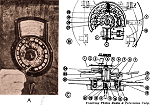 The old
pushbutton radio tuners were an ingenuous bit of electromechanical wizardry.
For those too young to have experienced them, operation was simple - turn the radio
tuning knob to your broadcast station, pull out the lever/button, and then push
it all the way back in. Done. The next time you pushed that button, the mechanism
would slew the dial indicator to that position, taking the tuning elements (usually
just a variable capacitor) with it. For most modern electronic radios, you program
the station button by pushing and holding it for a few seconds until a beep is heard.
My father never quite got the hang of tuning the pushbutton radio in his old Rambler
(vacuum tubes) or even his 1978 Chevy pickup truck (transistorized, but with mechanical
tuner). He was never an early - or late for that matter - adopter of new technology,
so it was not surprising. I am surprised, though, at the number of times I have
had to show a Millennial type how to program his/her late model car radio... The old
pushbutton radio tuners were an ingenuous bit of electromechanical wizardry.
For those too young to have experienced them, operation was simple - turn the radio
tuning knob to your broadcast station, pull out the lever/button, and then push
it all the way back in. Done. The next time you pushed that button, the mechanism
would slew the dial indicator to that position, taking the tuning elements (usually
just a variable capacitor) with it. For most modern electronic radios, you program
the station button by pushing and holding it for a few seconds until a beep is heard.
My father never quite got the hang of tuning the pushbutton radio in his old Rambler
(vacuum tubes) or even his 1978 Chevy pickup truck (transistorized, but with mechanical
tuner). He was never an early - or late for that matter - adopter of new technology,
so it was not surprising. I am surprised, though, at the number of times I have
had to show a Millennial type how to program his/her late model car radio...
 You really need to see these photos if you
do not know where and how most of the
lithium
for LiPo batteries originates. I have written in the past about the
environmental and human destruction
done in the pursuit of "green" goals. The end result is used to justify the means
- a truly deceptive tactic. The images in this story are from a more public relations
friendly source, but others can be found showing local natives wading through the
brine pools with rakes and squeegees, wearing minimum protective gear. Chile's high
and dry Atacama Desert (also home to the
Extremely Large
Telescope) is thought to contain about 40% of the world's lithium and much copper. You really need to see these photos if you
do not know where and how most of the
lithium
for LiPo batteries originates. I have written in the past about the
environmental and human destruction
done in the pursuit of "green" goals. The end result is used to justify the means
- a truly deceptive tactic. The images in this story are from a more public relations
friendly source, but others can be found showing local natives wading through the
brine pools with rakes and squeegees, wearing minimum protective gear. Chile's high
and dry Atacama Desert (also home to the
Extremely Large
Telescope) is thought to contain about 40% of the world's lithium and much copper.
 In Spring of 2018, I installed an old-fashioned
(but newly manufactured)
Channel Master CM3020 Advantage 100 television antenna on a short tower (maybe
just a pole) with a vintage Alliance Model U-100 Tenna-Rotor. While living in Erie,
Pennsylvania, under certain conditions I could receive broadcasts from Erie and
many of the cities that border close to Lake Erie like Toronto and Waterloo (home
of Blackberry), Canada and even Detroit, Michigan. AM radio stations are easily
pulled in from the same areas, but FM does not do quite so well. I plan to also
integrate some form of FM antenna on the installation. There is something insulting
about paying for cable or satellite TV and then having to suffer the deluge of commercials
as well (I have neither). Nobody likes sitting through commercials, but at least
if the programming is being delivered at no cost, it is not unreasonable for the
broadcast companies to be paid by product sponsors... In Spring of 2018, I installed an old-fashioned
(but newly manufactured)
Channel Master CM3020 Advantage 100 television antenna on a short tower (maybe
just a pole) with a vintage Alliance Model U-100 Tenna-Rotor. While living in Erie,
Pennsylvania, under certain conditions I could receive broadcasts from Erie and
many of the cities that border close to Lake Erie like Toronto and Waterloo (home
of Blackberry), Canada and even Detroit, Michigan. AM radio stations are easily
pulled in from the same areas, but FM does not do quite so well. I plan to also
integrate some form of FM antenna on the installation. There is something insulting
about paying for cable or satellite TV and then having to suffer the deluge of commercials
as well (I have neither). Nobody likes sitting through commercials, but at least
if the programming is being delivered at no cost, it is not unreasonable for the
broadcast companies to be paid by product sponsors...
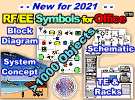 It was a lot of work, but I finally finished
a version of the "RF & Electronics Schematic & Block Diagram Symbols" that
works well with Microsoft Office™ programs Word™, Excel™, and Power Point™.
This is an equivalent of the extensive set of amplifier, mixer, filter, switch,
connector, waveguide, digital, analog, antenna, and other commonly used symbols
for system block diagrams and schematics created for Visio™. Each of the 1,000 or
so symbols was exported individually from Visio in the EMF file format, then imported
into Word on a Drawing Canvas. The EMF format allows an image to be scaled up or
down without becoming pixelated, so all the shapes can be resized in a document
and still look good. The imported symbols can also be UnGrouped into their original
constituent parts for editing. Check them out! It was a lot of work, but I finally finished
a version of the "RF & Electronics Schematic & Block Diagram Symbols" that
works well with Microsoft Office™ programs Word™, Excel™, and Power Point™.
This is an equivalent of the extensive set of amplifier, mixer, filter, switch,
connector, waveguide, digital, analog, antenna, and other commonly used symbols
for system block diagrams and schematics created for Visio™. Each of the 1,000 or
so symbols was exported individually from Visio in the EMF file format, then imported
into Word on a Drawing Canvas. The EMF format allows an image to be scaled up or
down without becoming pixelated, so all the shapes can be resized in a document
and still look good. The imported symbols can also be UnGrouped into their original
constituent parts for editing. Check them out!
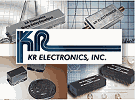 KR Electronics designs and manufactures
high quality filters for both the commercial and military markets. KR Electronics'
line of filters
includes lowpass, highpass, bandpass, bandstop and individually synthesized filters
for special applications - both commercial and military. State of the art computer
synthesis, analysis and test methods are used to meet the most challenging specifications.
All common connector types and package form factors are available. Please visit
their website today to see how they might be of assistance. Products are designed
and manufactured in the USA. KR Electronics designs and manufactures
high quality filters for both the commercial and military markets. KR Electronics'
line of filters
includes lowpass, highpass, bandpass, bandstop and individually synthesized filters
for special applications - both commercial and military. State of the art computer
synthesis, analysis and test methods are used to meet the most challenging specifications.
All common connector types and package form factors are available. Please visit
their website today to see how they might be of assistance. Products are designed
and manufactured in the USA.
Thursday the 5th
 Here are a couple more
electronics-themed comics from you that appeared in the October 1950 issue of
Radio & Television News magazine. The comic on page 50 might challenger
your ability to appreciate the situation. Television was still a relatively new
phenomenon and people were fanatical (the origin of "fan" is "fanatic") over it.
Crowds gathered in front of store windows containing a TV set to watch the magic
of the technology. The opportunity to watch live sporting events via television
was available to many people only at venues outside the home, as a TV was still
a middle class accessory at the time. Today when people gather around a TV set at
a bar, it is not because they could not watch it on their smartphones or home TV
sets or computers, but because they want the camaraderie of fellow fans. Although
I am tempted to assume most people "get" the gag in the page 167 comic, it could
very well be that not many are familiar with what a radio or TV antenna looks like,
since the ones they use are buried inside their phones. It is rare to see an old-fashioned
multi-element antenna on a house anymore, and the antennas on cell towers look nothing
like them. About the only place you see... Here are a couple more
electronics-themed comics from you that appeared in the October 1950 issue of
Radio & Television News magazine. The comic on page 50 might challenger
your ability to appreciate the situation. Television was still a relatively new
phenomenon and people were fanatical (the origin of "fan" is "fanatic") over it.
Crowds gathered in front of store windows containing a TV set to watch the magic
of the technology. The opportunity to watch live sporting events via television
was available to many people only at venues outside the home, as a TV was still
a middle class accessory at the time. Today when people gather around a TV set at
a bar, it is not because they could not watch it on their smartphones or home TV
sets or computers, but because they want the camaraderie of fellow fans. Although
I am tempted to assume most people "get" the gag in the page 167 comic, it could
very well be that not many are familiar with what a radio or TV antenna looks like,
since the ones they use are buried inside their phones. It is rare to see an old-fashioned
multi-element antenna on a house anymore, and the antennas on cell towers look nothing
like them. About the only place you see...
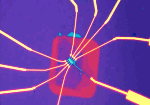 "Magic-angle
twisted bilayer graphene (MATBG) is a graphene-based material with a unique
structure, consisting of two graphene sheets layered on top of each other with a
misalignment of approximately 1.1°. This unique structure has been found to host
various interesting states, including correlated insulating states and unconventional
superconductivity. Past studies examining MATBG also unveiled the emergence of what
is known as a 'strange' metal regime in the proximity of the superconducting dome,
as well as a significantly enhanced electron-phonon coupling. While these observations
were confirmed by later works, the exact mechanisms underpinning them remain unclear.
Researchers at the Barcelona Institute of Science and Technology, the National Institute
for Material Sciences, and Massachusetts Institute of Technology (MIT) have recently
taken a closer look at these properties of MATBG using a different, low temperature
phase diagram than those utilized in previous works..." "Magic-angle
twisted bilayer graphene (MATBG) is a graphene-based material with a unique
structure, consisting of two graphene sheets layered on top of each other with a
misalignment of approximately 1.1°. This unique structure has been found to host
various interesting states, including correlated insulating states and unconventional
superconductivity. Past studies examining MATBG also unveiled the emergence of what
is known as a 'strange' metal regime in the proximity of the superconducting dome,
as well as a significantly enhanced electron-phonon coupling. While these observations
were confirmed by later works, the exact mechanisms underpinning them remain unclear.
Researchers at the Barcelona Institute of Science and Technology, the National Institute
for Material Sciences, and Massachusetts Institute of Technology (MIT) have recently
taken a closer look at these properties of MATBG using a different, low temperature
phase diagram than those utilized in previous works..."
 Long-held beliefs about just about every
subject are constantly being challenged by people who discover evidence that another
"truth" might be more valid. Bell's telephone vs. Gray, the Wright Brother's airplane
vs. Langley and Whitehead, etc. These days, it is great sport to attempt to discredit
someone of significant achievement. This article appeared on the IEEE Spectrum
website and questions whether J.J. Thompson actually discovered the electron
(aka the corpuscle). It begins: "'We shall call such particles corpuscles,' announced
the physicist J.J. Thomson, during a lecture at the Royal Institution in London,
on 30 April 1897. 'The atoms of the ordinary elements are made up of corpuscles
and holes, the holes being predominant,' he continued. Thomson described his experiments
with cathode rays to verify the existence of these subatomic corpuscles. This model
of the atom became known as the 'plum pudding' model, so named for the popular English
dessert. In Thomson's analogy, negatively charged corpuscles were like raisins suspended
in a positively charged cake, resulting in a neutral atom. The model also became
known as the Thomson model, although its chief proponent was William Thomson (Lord
Kelvin), not J.J. Thomson, who merely endorsed the idea..." Long-held beliefs about just about every
subject are constantly being challenged by people who discover evidence that another
"truth" might be more valid. Bell's telephone vs. Gray, the Wright Brother's airplane
vs. Langley and Whitehead, etc. These days, it is great sport to attempt to discredit
someone of significant achievement. This article appeared on the IEEE Spectrum
website and questions whether J.J. Thompson actually discovered the electron
(aka the corpuscle). It begins: "'We shall call such particles corpuscles,' announced
the physicist J.J. Thomson, during a lecture at the Royal Institution in London,
on 30 April 1897. 'The atoms of the ordinary elements are made up of corpuscles
and holes, the holes being predominant,' he continued. Thomson described his experiments
with cathode rays to verify the existence of these subatomic corpuscles. This model
of the atom became known as the 'plum pudding' model, so named for the popular English
dessert. In Thomson's analogy, negatively charged corpuscles were like raisins suspended
in a positively charged cake, resulting in a neutral atom. The model also became
known as the Thomson model, although its chief proponent was William Thomson (Lord
Kelvin), not J.J. Thomson, who merely endorsed the idea..."
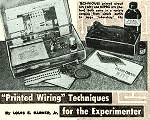 Here is the second of a 2-part article introducing
hobbyists to the relatively new technique of
printed circuit board (PCB) or, alternately, printed wiring board (PWB) fabrication.
Author Louis Garner is from Bell Telephone Labs, which was an early adopter of PWBs.
Bell had millions of relay switch and controller circuit boards for routing all
the country's telephone calls. I remember a couple times in high school while working
as an electrician's helper where we did some wiring inside a phone switching station
and saw row upon row of racks of identical panels full of relays. They were clacking
busily away in an almost deafening cacophony of non-synchronized noise. It was pretty
cool at first, but after an hour or so the novelty wore off and it became annoying.
Today, probably all you would hear in a telephone switching station is the sound
of cooling fans keeping all the ICs and hard drives within temperature specs... Here is the second of a 2-part article introducing
hobbyists to the relatively new technique of
printed circuit board (PCB) or, alternately, printed wiring board (PWB) fabrication.
Author Louis Garner is from Bell Telephone Labs, which was an early adopter of PWBs.
Bell had millions of relay switch and controller circuit boards for routing all
the country's telephone calls. I remember a couple times in high school while working
as an electrician's helper where we did some wiring inside a phone switching station
and saw row upon row of racks of identical panels full of relays. They were clacking
busily away in an almost deafening cacophony of non-synchronized noise. It was pretty
cool at first, but after an hour or so the novelty wore off and it became annoying.
Today, probably all you would hear in a telephone switching station is the sound
of cooling fans keeping all the ICs and hard drives within temperature specs...
 Antenova Ltd, the UK-based manufacturer of
antennas and RF antenna modules for M2M and the IoT, launches a new low-profile
antenna displaying strong performance on both Europe's 868 MHz bands and the
U.S. 915 MHz bands. The new
antenna is named "Lama," part number SRFI065. It was developed for small connected
devices operating on the LP-WAN networks including LoRa, Sigfox, Wi-SUN and MIoTy.
This antenna uses the ISM frequencies in Europe and America or both, which means
that one product design can be sold in both US and European markets. Lama is a particularly
small antenna, making it suited to designs with limited real estate. It is a flexible
printed circuit (FPC) antenna measuring 35 x 10 x 0.15 mm, supplied with a standard
100 mm RF cable with I-PEX MHF connector. This shape allows it to be mounted
several different ways in a design... Antenova Ltd, the UK-based manufacturer of
antennas and RF antenna modules for M2M and the IoT, launches a new low-profile
antenna displaying strong performance on both Europe's 868 MHz bands and the
U.S. 915 MHz bands. The new
antenna is named "Lama," part number SRFI065. It was developed for small connected
devices operating on the LP-WAN networks including LoRa, Sigfox, Wi-SUN and MIoTy.
This antenna uses the ISM frequencies in Europe and America or both, which means
that one product design can be sold in both US and European markets. Lama is a particularly
small antenna, making it suited to designs with limited real estate. It is a flexible
printed circuit (FPC) antenna measuring 35 x 10 x 0.15 mm, supplied with a standard
100 mm RF cable with I-PEX MHF connector. This shape allows it to be mounted
several different ways in a design...
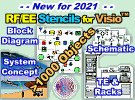 With more than 1000
custom-built stencils, this has got to be the most comprehensive set of
Visio Stencils available for RF, analog, and digital system and schematic
drawings! Every stencil symbol has been built to fit proportionally on the included
A-, B-, and C-size drawing page templates (or use your own page if preferred). Components
are provided for system block diagrams, conceptual drawings, schematics, test equipment,
racks (EIA 19", ETSI 21"), and more. Test equipment and racks are built at a 1:1
scale so that measurements can be made directly using Visio built-in dimensioning
objects. Page templates are provided with a preset scale (changeable) for a good
presentation that can incorporate all provided symbols... With more than 1000
custom-built stencils, this has got to be the most comprehensive set of
Visio Stencils available for RF, analog, and digital system and schematic
drawings! Every stencil symbol has been built to fit proportionally on the included
A-, B-, and C-size drawing page templates (or use your own page if preferred). Components
are provided for system block diagrams, conceptual drawings, schematics, test equipment,
racks (EIA 19", ETSI 21"), and more. Test equipment and racks are built at a 1:1
scale so that measurements can be made directly using Visio built-in dimensioning
objects. Page templates are provided with a preset scale (changeable) for a good
presentation that can incorporate all provided symbols...
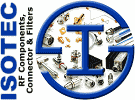 Since 1996, ISOTEC has designed, developed
and manufactured an extensive line of RF/microwave connectors, between-series adapters, RF components
and filters for wireless service providers including non-magnetic connectors for
quantum computing and MRI equipments etc. ISOTEC's product line includes low-PIM
RF connectors components such as power dividers and directional couplers. Off-the-shelf
and customized products up to 40 GHz and our low-PIM products can meet -160 dBc
with 2 tones and 20 W test. Quick prototyping, advanced in-house testing and
high-performance. Designs that are cost effective practical and repeatable. Since 1996, ISOTEC has designed, developed
and manufactured an extensive line of RF/microwave connectors, between-series adapters, RF components
and filters for wireless service providers including non-magnetic connectors for
quantum computing and MRI equipments etc. ISOTEC's product line includes low-PIM
RF connectors components such as power dividers and directional couplers. Off-the-shelf
and customized products up to 40 GHz and our low-PIM products can meet -160 dBc
with 2 tones and 20 W test. Quick prototyping, advanced in-house testing and
high-performance. Designs that are cost effective practical and repeatable.
Wednesday the 4th
 Here is Part 2 of a multi-part article
on radar that was published in Radio News magazine in 1945. Part 1
appeared a month earlier, and the series ran into the Fall. In the interim, World
War II was won and ended by the Allies. Interestingly, a lot of readers wrote
in to the magazine to criticize the divulging of sensitive technical information
on one of the era's most significant developments. Other than being able to generate
quality RF and analog signals (no digitization at this point), the most critical
subsystem of a radar is timing. Without precision accounting of the times of
transmission and reception, and of processing of the information for displaying
to the radar operator, the system is worse than useless. Improper timing will cause
confusion over where the detected target is in both azimuth and range. Positioning
your defense to counter an attack thought to be 10 miles out and due east,
when it is actually 2 miles away an approaching from the north could prove
devastating. In fact, one type of radar countermeasure attempts to create just that
scenario... Here is Part 2 of a multi-part article
on radar that was published in Radio News magazine in 1945. Part 1
appeared a month earlier, and the series ran into the Fall. In the interim, World
War II was won and ended by the Allies. Interestingly, a lot of readers wrote
in to the magazine to criticize the divulging of sensitive technical information
on one of the era's most significant developments. Other than being able to generate
quality RF and analog signals (no digitization at this point), the most critical
subsystem of a radar is timing. Without precision accounting of the times of
transmission and reception, and of processing of the information for displaying
to the radar operator, the system is worse than useless. Improper timing will cause
confusion over where the detected target is in both azimuth and range. Positioning
your defense to counter an attack thought to be 10 miles out and due east,
when it is actually 2 miles away an approaching from the north could prove
devastating. In fact, one type of radar countermeasure attempts to create just that
scenario...
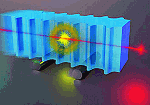 "In physics, as in life, it's always good
to look at things from different perspectives. Since the beginning of quantum physics,
how light moves and interacts with matter around it has mostly been described and
understood mathematically through the lens of its energy. In 1900, Max Planck used
energy to explain how light is emitted by heated objects, a seminal study in the
foundation of quantum mechanics. In 1905, Albert Einstein used energy when he introduced
the concept of photon. But light has another equally important quality, known as
momentum. And as it turns out, when you take momentum away, light starts behaving
in really interesting ways. An international team of physicists led by Michaël Lobet
and Eric Mazur, at the Harvard John A. Paulson School of Engineering and Applied
Sciences (SEAS), are re-examining the
foundations of quantum physics from the perspective of momentum and exploring
what happens when the momentum of light is reduced to zero..." "In physics, as in life, it's always good
to look at things from different perspectives. Since the beginning of quantum physics,
how light moves and interacts with matter around it has mostly been described and
understood mathematically through the lens of its energy. In 1900, Max Planck used
energy to explain how light is emitted by heated objects, a seminal study in the
foundation of quantum mechanics. In 1905, Albert Einstein used energy when he introduced
the concept of photon. But light has another equally important quality, known as
momentum. And as it turns out, when you take momentum away, light starts behaving
in really interesting ways. An international team of physicists led by Michaël Lobet
and Eric Mazur, at the Harvard John A. Paulson School of Engineering and Applied
Sciences (SEAS), are re-examining the
foundations of quantum physics from the perspective of momentum and exploring
what happens when the momentum of light is reduced to zero..."
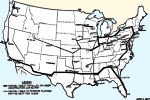 Nationwide
commercial television broadcasting companies wasted no time stringing coaxial
cable and microwave towers from sea to shining sea once the NTSC format standard
was adopted and manufacturers had spooled up production after World War II.
Adoption of cable services was slow because a fee was involved, but once purely
cable channels started being added the perceived value increase convinced consumers
to open their wallets. Eventually cable eclipsed over-the-air broadcasts for all
but extremely rural areas that were not serviced by cable. Along came satellite
TV to take care of filling that void. Once a small, inexpensive, unobtrusive Ka-band
antenna replaced the huge S-band backyard parabolic dishes and subscription prices
dropped significantly, suburbanites and city dwellers picked it up. Soon, cable
companies were feeling the pinch as their customer bases shrunk. Not ones to sit
and take the loss, "cable" exploited the rapidly falling landline subscriber base
due to cellular service by pushing VoIP via cable to the point where in some areas
you cannot even get legacy twisted Nationwide
commercial television broadcasting companies wasted no time stringing coaxial
cable and microwave towers from sea to shining sea once the NTSC format standard
was adopted and manufacturers had spooled up production after World War II.
Adoption of cable services was slow because a fee was involved, but once purely
cable channels started being added the perceived value increase convinced consumers
to open their wallets. Eventually cable eclipsed over-the-air broadcasts for all
but extremely rural areas that were not serviced by cable. Along came satellite
TV to take care of filling that void. Once a small, inexpensive, unobtrusive Ka-band
antenna replaced the huge S-band backyard parabolic dishes and subscription prices
dropped significantly, suburbanites and city dwellers picked it up. Soon, cable
companies were feeling the pinch as their customer bases shrunk. Not ones to sit
and take the loss, "cable" exploited the rapidly falling landline subscriber base
due to cellular service by pushing VoIP via cable to the point where in some areas
you cannot even get legacy twisted
 Rohde & Schwarz Australia will design
and manufacture an
integrated communications system (ICS) for the Royal Australian Navy (RAN) Hunter
Class Frigate Program (HCFP), following signature of a contract with BAE Systems
Australia's (BAESA) maritime division that allows for the addition of scopes of
work over time. Under the initial scope of the early engineering contract, Rohde &
Schwarz Australia will provide in country program management, systems engineering,
integration, installation and verification services for the acquisition and introduction
into service of the ICS. "The selection of Rohde & Schwarz Australia as Communications
System Integrator (CSI) in this early phase of the Hunter program is a clear validation
of the Commonwealth's and BAESA's intent to create opportunities for local industry
participation... Rohde & Schwarz Australia will design
and manufacture an
integrated communications system (ICS) for the Royal Australian Navy (RAN) Hunter
Class Frigate Program (HCFP), following signature of a contract with BAE Systems
Australia's (BAESA) maritime division that allows for the addition of scopes of
work over time. Under the initial scope of the early engineering contract, Rohde &
Schwarz Australia will provide in country program management, systems engineering,
integration, installation and verification services for the acquisition and introduction
into service of the ICS. "The selection of Rohde & Schwarz Australia as Communications
System Integrator (CSI) in this early phase of the Hunter program is a clear validation
of the Commonwealth's and BAESA's intent to create opportunities for local industry
participation...
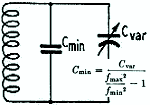 Although single capacitor, single inductor
resonant tank circuits are not widely used these days, one place you do find
them is in transistor amplifier stages in order to peak gain in a particular frequency
band. In this 1947 QST article, Author Jack Najork offers a few pointers
regarding the performing of quick mental calculations for how ranges of capacitance
values affect the resonant frequency. For instance, the ratio of capacitance values
needed to cover a certain range of resonant frequencies is equal (ideally) to the
square root of the frequency ratio. This comes into play both when determining values
during the design phase and the selecting of a variable capacitor for providing
tuning over a continuous range of frequencies. The same is true for inductor selection,
of course. BTW, the capacitance unit of μμfd is the same as what we today
term pF... Although single capacitor, single inductor
resonant tank circuits are not widely used these days, one place you do find
them is in transistor amplifier stages in order to peak gain in a particular frequency
band. In this 1947 QST article, Author Jack Najork offers a few pointers
regarding the performing of quick mental calculations for how ranges of capacitance
values affect the resonant frequency. For instance, the ratio of capacitance values
needed to cover a certain range of resonant frequencies is equal (ideally) to the
square root of the frequency ratio. This comes into play both when determining values
during the design phase and the selecting of a variable capacitor for providing
tuning over a continuous range of frequencies. The same is true for inductor selection,
of course. BTW, the capacitance unit of μμfd is the same as what we today
term pF...
 With more than 1000
custom-built stencils, this has got to be the most comprehensive set of
Visio Stencils available for RF, analog, and digital system and schematic
drawings! Every stencil symbol has been built to fit proportionally on the included
A-, B-, and C-size drawing page templates (or use your own page if preferred). Components
are provided for system block diagrams, conceptual drawings, schematics, test equipment,
racks (EIA 19", ETSI 21"), and more. Test equipment and racks are built at a 1:1
scale so that measurements can be made directly using Visio built-in dimensioning
objects. Page templates are provided with a preset scale (changeable) for a good
presentation that can incorporate all provided symbols... With more than 1000
custom-built stencils, this has got to be the most comprehensive set of
Visio Stencils available for RF, analog, and digital system and schematic
drawings! Every stencil symbol has been built to fit proportionally on the included
A-, B-, and C-size drawing page templates (or use your own page if preferred). Components
are provided for system block diagrams, conceptual drawings, schematics, test equipment,
racks (EIA 19", ETSI 21"), and more. Test equipment and racks are built at a 1:1
scale so that measurements can be made directly using Visio built-in dimensioning
objects. Page templates are provided with a preset scale (changeable) for a good
presentation that can incorporate all provided symbols...
 TotalTemp Technologies has more than 40 years
of combined experience providing thermal platforms.
Thermal Platforms
are available to provide temperatures between -100°C and +200°C for cryogenic cooling,
recirculating circulating coolers, temperature chambers and temperature controllers,
thermal range safety controllers, space simulation chambers, hybrid benchtop chambers,
custom systems and platforms. Manual and automated configurations for laboratory
and production environments. Please contact TotalTemp Technologies today to learn
how they can help your project. TotalTemp Technologies has more than 40 years
of combined experience providing thermal platforms.
Thermal Platforms
are available to provide temperatures between -100°C and +200°C for cryogenic cooling,
recirculating circulating coolers, temperature chambers and temperature controllers,
thermal range safety controllers, space simulation chambers, hybrid benchtop chambers,
custom systems and platforms. Manual and automated configurations for laboratory
and production environments. Please contact TotalTemp Technologies today to learn
how they can help your project.
Tuesday the 3rd
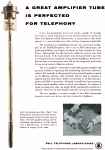 Contrary to the claim in this Bell Telephone
Laboratories promotional piece from a 1957 issue of Radio-Electronics magazine,
according to the Wikipedia entry for the
traveling wave tube (TWT) was invented in 1931 by Andrei "Andy" Haeff while
he was working as a doctoral student at the Kellogg Radiation Laboratory at Caltech.
His original patent, "Device for and Method of Controlling High Frequency Currents,"
was granted in 1936 (US2064469A). Bell gives credit to Dr. Rudolf Kompfner.
The TWT's wide bandwidth, 500 MHz in this case - was heralded as a major breakthrough
for supporting the rapidly growing microwave relay network spanning the country,
vastly increasing the number of concurrent telephone connections. By that time (1957)
transcontinental video broadcasts were also being made thanks to the system. It
would still be half a decade before satellites (e.g., Telstar) would be available
for long distance communications... Contrary to the claim in this Bell Telephone
Laboratories promotional piece from a 1957 issue of Radio-Electronics magazine,
according to the Wikipedia entry for the
traveling wave tube (TWT) was invented in 1931 by Andrei "Andy" Haeff while
he was working as a doctoral student at the Kellogg Radiation Laboratory at Caltech.
His original patent, "Device for and Method of Controlling High Frequency Currents,"
was granted in 1936 (US2064469A). Bell gives credit to Dr. Rudolf Kompfner.
The TWT's wide bandwidth, 500 MHz in this case - was heralded as a major breakthrough
for supporting the rapidly growing microwave relay network spanning the country,
vastly increasing the number of concurrent telephone connections. By that time (1957)
transcontinental video broadcasts were also being made thanks to the system. It
would still be half a decade before satellites (e.g., Telstar) would be available
for long distance communications...
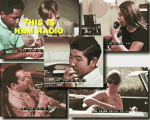 This promotional film (now an online video)
entitled "This Is Ham
Radio" was produced by the American Radio Relay League (ARRL) circa 1970. It
shows the many aspects of amateur radio including building and operating transmitters
and receivers, erecting antennas, and engaging in contests - in both fixed and mobile
venues. At that time, entrance into the world of Ham radio was tougher than it is
nowadays because proficiency at Morse code was required - a minimum of five words
per minute sending and receiving. The entire pool of questions and answers was not
readily available for studying for the written exam either, like it is today. For
those who like to accuse organizations of ignoring and/or discouraging the participation
of anyone other than White males, please note care was taken to include Blacks,
Latinos, Asians, women and girls, youngsters and seniors. That was more than half
a century ago. In fact, some of this footage is borrowed from an earlier ARRL film
made in the 1960s and narrated by Senator Barry Goldwater (K7UGA), demonstrating
an even longer-ago inclusionary effort. Since that time, many more resources have
been invested... This promotional film (now an online video)
entitled "This Is Ham
Radio" was produced by the American Radio Relay League (ARRL) circa 1970. It
shows the many aspects of amateur radio including building and operating transmitters
and receivers, erecting antennas, and engaging in contests - in both fixed and mobile
venues. At that time, entrance into the world of Ham radio was tougher than it is
nowadays because proficiency at Morse code was required - a minimum of five words
per minute sending and receiving. The entire pool of questions and answers was not
readily available for studying for the written exam either, like it is today. For
those who like to accuse organizations of ignoring and/or discouraging the participation
of anyone other than White males, please note care was taken to include Blacks,
Latinos, Asians, women and girls, youngsters and seniors. That was more than half
a century ago. In fact, some of this footage is borrowed from an earlier ARRL film
made in the 1960s and narrated by Senator Barry Goldwater (K7UGA), demonstrating
an even longer-ago inclusionary effort. Since that time, many more resources have
been invested...
 "There have been a variety of demonstrations
of the capabilities that
atomically thin materials can bring to electronics - extremely small size, excellent
performance, and some distinctive properties. But almost all of these demonstrations
required that the electronics being tested were essentially assembled by hand. Materials
like graphene are often placed on a surface at random, and then the wiring needed
for it to function is built around that location. It's not exactly a recipe for
mass production. To the extent there's been some progress, it's been limited. One
of the more recent efforts involved using graphene and molybdenum disulfide to make
the transistor with the smallest gate length. In this case, the two atomically thin
materials had to be placed carefully, but not exactly. Any excess material was etched
away, and a key feature was made by cutting through the graphene sheet..." "There have been a variety of demonstrations
of the capabilities that
atomically thin materials can bring to electronics - extremely small size, excellent
performance, and some distinctive properties. But almost all of these demonstrations
required that the electronics being tested were essentially assembled by hand. Materials
like graphene are often placed on a surface at random, and then the wiring needed
for it to function is built around that location. It's not exactly a recipe for
mass production. To the extent there's been some progress, it's been limited. One
of the more recent efforts involved using graphene and molybdenum disulfide to make
the transistor with the smallest gate length. In this case, the two atomically thin
materials had to be placed carefully, but not exactly. Any excess material was etched
away, and a key feature was made by cutting through the graphene sheet..."
 Exodus Advanced Communications, a multinational
RF communication equipment and engineering service company serving both commercial
and government entities and their affiliates worldwide, announces their model
AMP2073BDB-LC, a rugged compact dual-band 700 MHz to 10.0 GHz, solid
state broadband amplifier. Class A/AB design for all applications and industry standards.
This amplifier produces 200 W, 700 MHz to 6.0 GHz & 100W 6.0
to 10.0 GHz with 53 dB gain. Unprecedented performance as compared to
TWT's with forward/reflected power monitoring in dBm & watts, VSWR, voltage/current/temperature
sensing for extreme reliability. 30 kg's in a compact 5U chassis 8.75"H x 19"W
x 27"D... Exodus Advanced Communications, a multinational
RF communication equipment and engineering service company serving both commercial
and government entities and their affiliates worldwide, announces their model
AMP2073BDB-LC, a rugged compact dual-band 700 MHz to 10.0 GHz, solid
state broadband amplifier. Class A/AB design for all applications and industry standards.
This amplifier produces 200 W, 700 MHz to 6.0 GHz & 100W 6.0
to 10.0 GHz with 53 dB gain. Unprecedented performance as compared to
TWT's with forward/reflected power monitoring in dBm & watts, VSWR, voltage/current/temperature
sensing for extreme reliability. 30 kg's in a compact 5U chassis 8.75"H x 19"W
x 27"D...
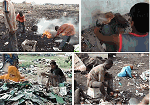 Every once in a while someone upsets our
comfortable existence by pointing out inconvenient realities like the problem of
what happens to our electronics devices after the manufacturers convince us that
we need the latest version of their wonder gadget. Unlike regular household recyclables
like glass jars and cardboard cereal boxes, electronic devices contain a lot of
valuable material that makes it profitable for reclamation if the work can be performed
somewhere nobody really cares about the human costs of doing so. In China, India,
Ghana, and many other "developing" countries, poor souls earn an existence by disassembling
and performing crude processing of the components to separate heavy metals like
gold, silver, lead, cadmium, beryllium, mercury, and others. For their efforts they
sell their booty at a pauper's wage. After removing high value individual components
like CPUs and RAM, as in these videos the rest is tossed into a fire to burn away
the non-metals. If it is hot enough, the metals melt and drip onto a collection
pan below. Wire is stripped of its insulation to yield only the copper or aluminum
by burning off the plastic or rubber sheathing. The fumes from insulation often
is toxic. Imagine inhaling that crap all day, every day. The level of pollutants
leeching into the ground water supply and into the air are severe. From young to
old, everyone participates. The U.S. Environmental Protection Agency masks the truth
about what really happens to your exported e-waste..." Every once in a while someone upsets our
comfortable existence by pointing out inconvenient realities like the problem of
what happens to our electronics devices after the manufacturers convince us that
we need the latest version of their wonder gadget. Unlike regular household recyclables
like glass jars and cardboard cereal boxes, electronic devices contain a lot of
valuable material that makes it profitable for reclamation if the work can be performed
somewhere nobody really cares about the human costs of doing so. In China, India,
Ghana, and many other "developing" countries, poor souls earn an existence by disassembling
and performing crude processing of the components to separate heavy metals like
gold, silver, lead, cadmium, beryllium, mercury, and others. For their efforts they
sell their booty at a pauper's wage. After removing high value individual components
like CPUs and RAM, as in these videos the rest is tossed into a fire to burn away
the non-metals. If it is hot enough, the metals melt and drip onto a collection
pan below. Wire is stripped of its insulation to yield only the copper or aluminum
by burning off the plastic or rubber sheathing. The fumes from insulation often
is toxic. Imagine inhaling that crap all day, every day. The level of pollutants
leeching into the ground water supply and into the air are severe. From young to
old, everyone participates. The U.S. Environmental Protection Agency masks the truth
about what really happens to your exported e-waste..."
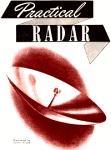 After having begun my electronics career
in the USAF as an
airport surveillance radar technician, my interest is always piqued by articles
on the subject. Like so many other types of electronics, radar is so common today
that not many people think it is anything special - just another convenience that
has been around for as long as they can recall - and indeed it likely has been since
radar was first put into practical operation in the early 1940s. In 1945, the last
year of World War II, Radio News magazine ran a multi-month series on radar
system theory of operation and design. When I look at the detailed block diagram,
it brings back memories of the MPN-14 search and precision approach radar systems
that I worked on. In tech school at Keesler AFB, Mississippi, we spent nine months
for 7 hours per day, five days per week with piles of schematics learning stage
by stage how the entire system worked. The primary radar systems, VHF, and UHF navigation
radios were vacuum tube based, while the Identification Friend or Foe (IFF)... After having begun my electronics career
in the USAF as an
airport surveillance radar technician, my interest is always piqued by articles
on the subject. Like so many other types of electronics, radar is so common today
that not many people think it is anything special - just another convenience that
has been around for as long as they can recall - and indeed it likely has been since
radar was first put into practical operation in the early 1940s. In 1945, the last
year of World War II, Radio News magazine ran a multi-month series on radar
system theory of operation and design. When I look at the detailed block diagram,
it brings back memories of the MPN-14 search and precision approach radar systems
that I worked on. In tech school at Keesler AFB, Mississippi, we spent nine months
for 7 hours per day, five days per week with piles of schematics learning stage
by stage how the entire system worked. The primary radar systems, VHF, and UHF navigation
radios were vacuum tube based, while the Identification Friend or Foe (IFF)...
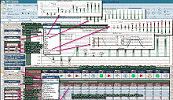 RF Cascade Workbook is the next phase in the evolution of
RF Cafe's long-running series, RF Cascade Workbook. Chances are you have
never used a spreadsheet quite like this (click here for screen capture). It is a full-featured RF system
cascade parameter and frequency planner that includes filters and mixers for a mere
$45. Built in MS Excel, using RF Cascade Workbook 2018 is a cinch
and the format is entirely customizable. It is significantly easier and faster than
using a multi-thousand dollar simulator when a high level system analysis is all
that is needed. An intro video takes you through the main features...
RF Cascade Workbook is the next phase in the evolution of
RF Cafe's long-running series, RF Cascade Workbook. Chances are you have
never used a spreadsheet quite like this (click here for screen capture). It is a full-featured RF system
cascade parameter and frequency planner that includes filters and mixers for a mere
$45. Built in MS Excel, using RF Cascade Workbook 2018 is a cinch
and the format is entirely customizable. It is significantly easier and faster than
using a multi-thousand dollar simulator when a high level system analysis is all
that is needed. An intro video takes you through the main features...
 Innovative Power Products (IPP) has over
35 years of experience designing & manufacturing RF & microwave passive
components. Their high power, broadband
couplers, combiners, resistors, baluns, terminations
and attenuators are fabricated using the latest materials and design tools available,
resulting in unrivaled product performance. Applications in military, medical, industrial
and commercial markets are serviced around the world. Products listed on website
link to detailed mechanical drawings that contain electrical specifications as well
as performance data. Please take a couple minutes to visit their website and see
how IPP can help you today. Innovative Power Products (IPP) has over
35 years of experience designing & manufacturing RF & microwave passive
components. Their high power, broadband
couplers, combiners, resistors, baluns, terminations
and attenuators are fabricated using the latest materials and design tools available,
resulting in unrivaled product performance. Applications in military, medical, industrial
and commercial markets are serviced around the world. Products listed on website
link to detailed mechanical drawings that contain electrical specifications as well
as performance data. Please take a couple minutes to visit their website and see
how IPP can help you today.
Monday the 2nd
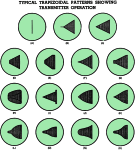 Being able to quickly interpret
oscilloscope waveforms is essential to efficient circuit design, adjustment,
and troubleshooting. Knowing tell-tale signatures of signal-corrupting influences
from unintended resistance, capacitance, inductance, and nonlinear devices is a
huge advantage when using an o-scope. Equally important is not introducing waveform-
and function-altering effects with probing techniques and/or incorrect operation
of the test equipment. One often seen example of the latter is using equipment whose
input impedance is not proper for the UUT; e.g., wrong impedance coaxial cable in
RF situations or too low of an input impedance for low frequency applications that
either loads the circuit to the point of malfunction or where the voltage division
is significant enough to cause improper readings on the display. Note the interesting
comment at the beginning of this October 1945 Radio News magazine article
regarding restoration of transmitting privileges for amateur radio operators at
the end of WWII... Being able to quickly interpret
oscilloscope waveforms is essential to efficient circuit design, adjustment,
and troubleshooting. Knowing tell-tale signatures of signal-corrupting influences
from unintended resistance, capacitance, inductance, and nonlinear devices is a
huge advantage when using an o-scope. Equally important is not introducing waveform-
and function-altering effects with probing techniques and/or incorrect operation
of the test equipment. One often seen example of the latter is using equipment whose
input impedance is not proper for the UUT; e.g., wrong impedance coaxial cable in
RF situations or too low of an input impedance for low frequency applications that
either loads the circuit to the point of malfunction or where the voltage division
is significant enough to cause improper readings on the display. Note the interesting
comment at the beginning of this October 1945 Radio News magazine article
regarding restoration of transmitting privileges for amateur radio operators at
the end of WWII...
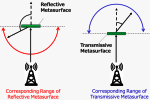 "Kyocera has developed a
Transmissive Metasurface technology that can redirect wireless network signals
in a specific direction to improve the coverage area and performance of 5G and eventually
6G networks. The Transmissive Metasurface will help deliver high-frequency millimeter-wave
5G and 6G to places where communication is impossible due to obstacles, expanding
service areas beyond the capability of conventional Reflective Metasurface technologies
used today. The 28 GHz band used in 5G networks, and the higher frequency band being
studied for 6G, have a high degree of rectilinear propagation. Signals often cannot
reach locations where a direct line of sight to the base station is obstructed..." "Kyocera has developed a
Transmissive Metasurface technology that can redirect wireless network signals
in a specific direction to improve the coverage area and performance of 5G and eventually
6G networks. The Transmissive Metasurface will help deliver high-frequency millimeter-wave
5G and 6G to places where communication is impossible due to obstacles, expanding
service areas beyond the capability of conventional Reflective Metasurface technologies
used today. The 28 GHz band used in 5G networks, and the higher frequency band being
studied for 6G, have a high degree of rectilinear propagation. Signals often cannot
reach locations where a direct line of sight to the base station is obstructed..."
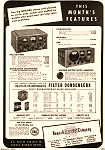 Who among us has not ordered electronic
components or hardware from
Newark Electronics? Now known officially as "Newark element 14" (silicon?),
and before that Newark Electronics, the company began life as Newark Electric Company,
as shown in this 1946 advertisement that appeared in Radio-News. In the
days before Digi-Key and the Internet, Newark and Allied were the standards for
me when ordering stuff in the lab. Weekly long distance phone calls(remember when
they were called that?) to Newark were the routine. Unless a project was really
hot, standard U.S. Post Office delivery was used since at the time UPS and FedEx
were deemed by the bean counters to be too exotic and expensive to justify the additional
cost... Who among us has not ordered electronic
components or hardware from
Newark Electronics? Now known officially as "Newark element 14" (silicon?),
and before that Newark Electronics, the company began life as Newark Electric Company,
as shown in this 1946 advertisement that appeared in Radio-News. In the
days before Digi-Key and the Internet, Newark and Allied were the standards for
me when ordering stuff in the lab. Weekly long distance phone calls(remember when
they were called that?) to Newark were the routine. Unless a project was really
hot, standard U.S. Post Office delivery was used since at the time UPS and FedEx
were deemed by the bean counters to be too exotic and expensive to justify the additional
cost...
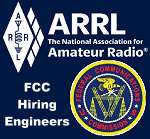 From the ARRL website: "The Federal Communications
Commission (FCC) has started
accepting
applications for electronics engineers for Recent Graduates positions in the
Pathways Program which is located in the Office of Engineering and Technology in
Washington, DC. Candidates should be recent graduates for this one year developmental
program which may lead to a term or permanent appointment. Training will cover the
agency's policy and rulemaking processes, technical training for a wide variety
of telecommunications services and technologies, and training on engineering and
policy principles relevant to the fast paced telecommunications industry. Additional
duties, and related training, may also include performing propagation analysis of
terrestrial, satellite..." One catch - you must get the jab. From the ARRL website: "The Federal Communications
Commission (FCC) has started
accepting
applications for electronics engineers for Recent Graduates positions in the
Pathways Program which is located in the Office of Engineering and Technology in
Washington, DC. Candidates should be recent graduates for this one year developmental
program which may lead to a term or permanent appointment. Training will cover the
agency's policy and rulemaking processes, technical training for a wide variety
of telecommunications services and technologies, and training on engineering and
policy principles relevant to the fast paced telecommunications industry. Additional
duties, and related training, may also include performing propagation analysis of
terrestrial, satellite..." One catch - you must get the jab.
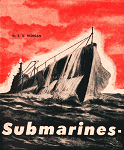 Submarines first proved their deadly capabilities
during World War I and then again in World War II when Adolph Hitler's
navy used the formidable U-Boats (Unterseeboot, "under-sea-boat") to torpedo not
just military ships but merchant ships in commercial trade routes between the Americas
and Europe. Hideki Tojo's navy used subs to conduct surveillance prior to the deadly
surprise attack on Pearl Harbor. Their naturally stealthy environment - underwater
- proved to be a difficult realm both for detection and for attack. Fortunately,
sensor technology developed quickly during the war, and soon a combination of air
and sea based methods were in use and proved very effective. Submariners no longer
sailed in relative security from being treated to a violent, icy burial at sea.
By the mid 1950s, when this article was published, we had detection capabilities
that included direct visual, photographic, radar, sonar, and magnetic means... Submarines first proved their deadly capabilities
during World War I and then again in World War II when Adolph Hitler's
navy used the formidable U-Boats (Unterseeboot, "under-sea-boat") to torpedo not
just military ships but merchant ships in commercial trade routes between the Americas
and Europe. Hideki Tojo's navy used subs to conduct surveillance prior to the deadly
surprise attack on Pearl Harbor. Their naturally stealthy environment - underwater
- proved to be a difficult realm both for detection and for attack. Fortunately,
sensor technology developed quickly during the war, and soon a combination of air
and sea based methods were in use and proved very effective. Submariners no longer
sailed in relative security from being treated to a violent, icy burial at sea.
By the mid 1950s, when this article was published, we had detection capabilities
that included direct visual, photographic, radar, sonar, and magnetic means...
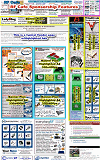 New Scheme rotates
all Banners in all locations on the page! RF Cafe typically receives 8,000-15,000
website visits each weekday.
RF Cafe is a favorite
of engineers, technicians, hobbyists, and students all over the world. With more
than 12,000 pages in the Google search index, RF Cafe returns in favorable
positions on many types of key searches, both for text and images. New content is
added on a daily basis, which keeps the major search engines interested enough to
spider it multiple times each day. Items added on the homepage often can be found
in a Google search within a few hours of being posted. I also re-broadcast homepage
items on LinkedIn. If you need your company news to be seen, RF Cafe is the
place to be. New Scheme rotates
all Banners in all locations on the page! RF Cafe typically receives 8,000-15,000
website visits each weekday.
RF Cafe is a favorite
of engineers, technicians, hobbyists, and students all over the world. With more
than 12,000 pages in the Google search index, RF Cafe returns in favorable
positions on many types of key searches, both for text and images. New content is
added on a daily basis, which keeps the major search engines interested enough to
spider it multiple times each day. Items added on the homepage often can be found
in a Google search within a few hours of being posted. I also re-broadcast homepage
items on LinkedIn. If you need your company news to be seen, RF Cafe is the
place to be.
 Since 2003, Bittele Electronics has consistently
provided low-volume, electronic contract manufacturing (ECM) and turnkey PCB assembly
services. It specializes in board level turnkey
PCB assembly
for design engineers needing low volume or prototype multi-layer printed circuit
boards. Free Passive Components: Bittele
Electronics is taking one further step in its commitment of offering the best service
to clients of its PCB assembly business. Bittele is now offering common passive
components to its clients FREE of Charge. Since 2003, Bittele Electronics has consistently
provided low-volume, electronic contract manufacturing (ECM) and turnkey PCB assembly
services. It specializes in board level turnkey
PCB assembly
for design engineers needing low volume or prototype multi-layer printed circuit
boards. Free Passive Components: Bittele
Electronics is taking one further step in its commitment of offering the best service
to clients of its PCB assembly business. Bittele is now offering common passive
components to its clients FREE of Charge.
Sunday the 1st
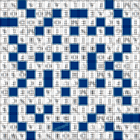 Here is your custom made
RF & Microwaves themed crossword puzzle for May 1st, 2022. All RF Cafe crossword
puzzles are custom made by me, Kirt Blattenberger, and have only words and clues
related to RF, microwave, and mm-wave engineering, optics, mathematics, chemistry,
physics, and other technical subjects. As always, this crossword contains no names
of politicians, mountain ranges, exotic foods or plants, movie stars, or anything
of the sort unless it/he/she is related to this puzzle's technology theme (e.g.,
Reginald Denny or the Tunguska event in Siberia). The technically inclined cruciverbalists
amongst us will appreciate the effort. Enjoy! Here is your custom made
RF & Microwaves themed crossword puzzle for May 1st, 2022. All RF Cafe crossword
puzzles are custom made by me, Kirt Blattenberger, and have only words and clues
related to RF, microwave, and mm-wave engineering, optics, mathematics, chemistry,
physics, and other technical subjects. As always, this crossword contains no names
of politicians, mountain ranges, exotic foods or plants, movie stars, or anything
of the sort unless it/he/she is related to this puzzle's technology theme (e.g.,
Reginald Denny or the Tunguska event in Siberia). The technically inclined cruciverbalists
amongst us will appreciate the effort. Enjoy!
 This assortment of custom-designed themes
by RF Cafe includes T-Shirts, Mouse Pads, Clocks, Tote Bags, Coffee Mugs and Steins,
Purses, Sweatshirts, and Baseball Caps. Choose from amazingly clever "We Are the World's
Matchmakers" Smith chart design or the "Engineer's Troubleshooting Flow Chart."
My "Matchmaker's" design has been ripped off by other people and used on their products,
so please be sure to purchase only official RF Cafe gear. My markup is only a paltry
50¢ per item - Cafe Press gets the rest of your purchase price. These would make
excellent gifts for husbands, wives, kids, significant others, and for handing out
at company events or as rewards for excellent service. It's a great way to help
support RF Cafe. Thanks... This assortment of custom-designed themes
by RF Cafe includes T-Shirts, Mouse Pads, Clocks, Tote Bags, Coffee Mugs and Steins,
Purses, Sweatshirts, and Baseball Caps. Choose from amazingly clever "We Are the World's
Matchmakers" Smith chart design or the "Engineer's Troubleshooting Flow Chart."
My "Matchmaker's" design has been ripped off by other people and used on their products,
so please be sure to purchase only official RF Cafe gear. My markup is only a paltry
50¢ per item - Cafe Press gets the rest of your purchase price. These would make
excellent gifts for husbands, wives, kids, significant others, and for handing out
at company events or as rewards for excellent service. It's a great way to help
support RF Cafe. Thanks...
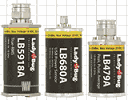 LadyBug Technologies was founded in 2004
by two microwave engineers with a passion for quality microwave test instrumentation.
Our employees offer many years experience in the design and manufacture of the worlds
best vector network analyzers, spectrum analyzers, power meters and associated components.
The management team has additional experience in optical power testing, military
radar and a variety of programming environments including LabVIEW, VEE and other
languages often used in programmatic systems. Extensive experience in a broad spectrum
of demanding measurement applications. You can be assured that our Power Sensors
are designed, built, tested and calibrated without compromise. LadyBug Technologies was founded in 2004
by two microwave engineers with a passion for quality microwave test instrumentation.
Our employees offer many years experience in the design and manufacture of the worlds
best vector network analyzers, spectrum analyzers, power meters and associated components.
The management team has additional experience in optical power testing, military
radar and a variety of programming environments including LabVIEW, VEE and other
languages often used in programmatic systems. Extensive experience in a broad spectrum
of demanding measurement applications. You can be assured that our Power Sensors
are designed, built, tested and calibrated without compromise.
These archive pages are provided in order to make it easier for you to find items
that you remember seeing on the RF Cafe homepage. Of course probably the easiest
way to find anything on the website is to use the "Search
RF Cafe" box at the top of every page.
About RF Cafe.
Homepage Archive Pages
2024:
Jan |
Feb |
Mar |
Apr |
May |
Jun |
Jul |
Aug |
Sep |
Oct |
Nov |
Dec
2023:
Jan |
Feb |
Mar |
Apr |
May |
Jun |
Jul |
Aug |
Sep |
Oct |
Nov |
Dec
2022:
Jan |
Feb |
Mar |
Apr |
May |
Jun |
Jul |
Aug |
Sep |
Oct |
Nov |
Dec
2021:
Jan |
Feb |
Mar |
Apr |
May |
Jun |
Jul |
Aug |
Sep |
Oct |
Nov |
Dec
2020:
Jan |
Feb |
Mar |
Apr |
May |
Jun |
Jul |
Aug |
Sep |
Oct |
Nov |
Dec
2019:
Jan |
Feb |
Mar |
Apr |
May |
Jun |
Jul |
Aug |
Sep |
Oct |
Nov |
Dec
2018:
Jan |
Feb |
Mar |
Apr |
May |
Jun |
Jul |
Aug |
Sep |
Oct |
Nov |
Dec
2017:
Jan |
Feb |
Mar |
Apr |
May |
Jun |
Jul |
Aug |
Sep |
Oct |
Nov |
Dec
2016:
Jan |
Feb |
Mar |
Apr |
May |
Jun |
Jul |
Aug |
Sep |
Oct |
Nov |
Dec
2015:
Jan |
Feb |
Mar |
Apr |
May |
Jun |
Jul |
Aug |
Sep |
Oct |
Nov |
Dec
2014:
Jan |
Feb |
Mar |
Apr |
May |
Jun |
Jul |
Aug |
Sep |
Oct |
Nov |
Dec
2013:
Jan |
Feb |
Mar |
Apr |
May |
Jun |
Jul |
Aug |
Sep |
Oct |
Nov |
Dec
2012:
1 |
2 |
3 |
4 |
5 |
6 |
7 |
8 |
9 |
10 |
11 |
12 |
13 (no archives before 2012)
|















 KR Electronics
KR Electronics














 "There have been a variety of demonstrations
of the capabilities that
"There have been a variety of demonstrations
of the capabilities that









 Submarines
Submarines



 LadyBug Technologies
LadyBug Technologies